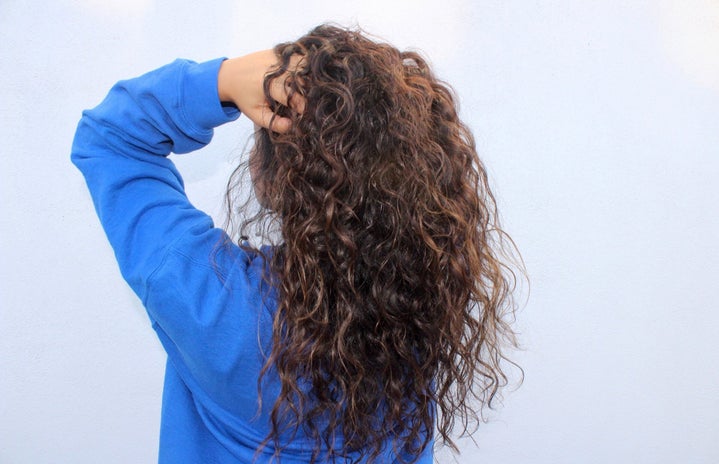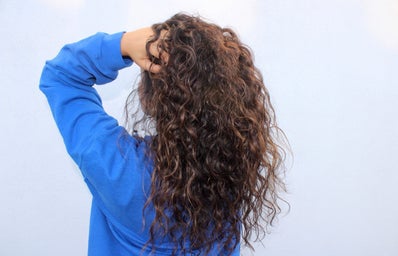I still remember the sizzling sounds as I cautiously slid the flat iron down a portion of my hair — during which I’d repeat a silent prayer that the 320 degree celsius was not going to burn off my head, and that my straightened hair would last the day. In my teens, straight hair was “beautiful” and anything that veered away from that was undesirable — especially thick, curly, and dry hair.
That $150 rebonding package plus $50 treatment was my literal dream.
Growing up, there was a certain shame attached to my natural curly hair. Hearing the remarks “Eh you never use conditioner one ah?”, “do you comb your hair?” along with requests to touch my hair because of how “interesting” it looked, were not uncommon. Curly hair was perceived to be messy, and the countless hair advertisements around me with that stereotypical straight, silky hair did not make things any better because that was, and continues to be, the standard of beauty. Where do my “wild” curls and frizz fit in then?
For the longest time, I believed that I was unattractive and ugly because my hair could not be “tamed.” I tried so many “hydrating” hair products on the market; Herbal Essence, Pantene, SilkPro… you name it — none of which worked out. What could I do? It’s a known fact that as curly hair is naturally dry, it’s harder for curls to attain the moisture it needs as compared to the “average” straight hair. Sadly, there was never a 101 on how to manage curly hair, and neither were curly-hair specific products at arm’s reach. I just knew that the formula of [insert trendy shampoo] + [conditioner that comes with it] + [insert hair serum the very Chinese salon convinced me to buy] was not working for me.
Coming from an Indian family, coconut oil was proposed as a solution to all my hair troubles (of course). But you see, even the mention of coconut oil repelled me because all its amazing moisturising qualities were overshadowed by my fear of being categorised as a “smelly Indian” — a racially charged stereotype tied to our quotidian use of coconut oil and its potent smell. (In hindsight, there was clearly a lot of internalised racism at work.)
I think loving my hair (and ultimately myself) was an unfathomable concept to me, a brown woman, because nobody had really attached the idea of beauty to brownness before — at least the kind that was not borderline exoticism. I started to decentralise this idea of beauty when people began to co-opt the hashtag #brownis… and share their uniquely brown experiences — to me, a big part of that identity is our hair. To quote The Substation’s performance, Brown is Haram (2021) “Brown is… locks of luscious hair.”
(Apart from The Substation performance by writer and artist @heymysara, some of the contents that have also inspired me included @sudezna‘s Brown is… post, which started a domino effect of celebrations of our brown identities.)
My gradual self acceptance came firstly from the influx of people I follow flaunting their curls — big, small, and anything in between. The increasingly accessible knowledge on how to maintain different types of curly hair made the seeming impossibility of attaining smooth, non-frizzy curls, a reality. Most importantly, it challenged the ideas of beauty that I had internalised and defined myself against.
Disclaimer: there is no such thing as permanently non-frizzy hair, this journey involves embracing the frizz as well.
While curly hair products remain scarce in our physical stores (still deeply problematic), the brown community has been doing the good labour of providing individuals like myself the tools and knowledge that we need to embrace our curls. For me, the Instagram account, @haircarebymon has been integral to this journey. Besides that, talking to my fellow brown queens about their hair care routines introduced me to various affordable curly hair products and hacks. It was so comforting to know that I was not the only one figuring things out.
As brown women especially, we need to have these conversations about the shame we attach to what is uniquely us — in this case, curly hair. Community is so important, I’m glad these spaces that support and express solidarity with brown experiences exist in social media. If this curly hair journey has taught me anything at all, it’s the fact that there are so many types of curly hair and while one routine may work wonders for some, it may not be the case for all. @haircarebymon’s post on her full hair care routine which I found to be a good guideline.
As for myself, I’m currently using SheaMoisture’s Curl Moisture Co-wash. I try my best to stay away from chemically heavy products and I use a lot more coconut oil (but in moderation because it affects your scalp when you leave oily substances in your hair for too long). Also, I now dry my hair using an old t-shirt instead of a regular towel to protect my curls and prevent frizz (I learnt this from a friend). Lastly, SheaMoisture’s curl cream is a must for me! I wouldn’t say I’ve perfected the routine, I’m consciously caring for my curls but also understanding that it’s a constant learning curve.
To all my curly girls who are figuring it out, you’re not alone! All I can say is that paying more attention to my natural hair and embracing it is a big part of loving myself as a brown woman. It feels so much lighter to know that I don’t have to keep up with some impossible beauty standard to feel beautiful — it’s about damn time!


